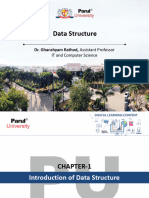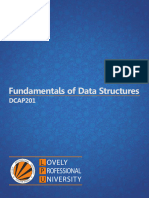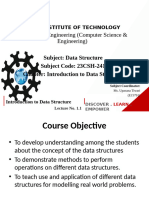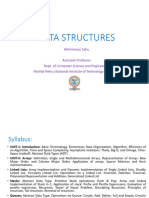0 ratings0% found this document useful (0 votes)
18 viewsIntroduction To Data Structures and Algorithms
Uploaded by
milesjianne.cellacayCopyright
© © All Rights Reserved
Available Formats
Download as PPTX, PDF, TXT or read online on Scribd
0 ratings0% found this document useful (0 votes)
18 viewsIntroduction To Data Structures and Algorithms
Uploaded by
milesjianne.cellacayCopyright
© © All Rights Reserved
Available Formats
Download as PPTX, PDF, TXT or read online on Scribd
You are on page 1/ 14
Bohol Island State University
INTRO TO DATA
STRUCTURES AND
ALGORITHMS
Alma Mae B. Auxtero
Learning Objectives
• Discuss the need for using data structures and
algorithms in computer programming
• classify data structures based on their
organization of elements; and
• illustrate a real-world problem and determine the
type of data structure that you can use to solve it.
Basic Concepts
• Data object - represents an object having data.
• Data type - a classification of data such as integer, string,
etc.
⚬ the data type determines the values that can be
assigned and the operations that can be performed
with the corresponding data type.
• Two classification of data types in Java:
⚬ Built-in Data type
⚬ Derived Data tpye
Basic Concepts
• Built-in Data type - data types with built-in support in a certain
language.
⚬ integers
⚬ boolean
⚬ float
⚬ character and strings
• Derived data type - data types that are implementation-
independent. It means that we can implement them in one way or
another.
⚬ List
⚬ Array
⚬ Stack
⚬ Queue
Why Data Structures
• Variables store data in a program. Now, once we have
several data in our program, it can get complicated, and
the data gets larger each day.
• Consequently, problems arise.
a. Processor speed - To handle large data, high-speed
processing is needed.
b. Data Search - Consider a company with 1,000
employees. If our system needs to search for
employee data, it needs to search through at most
1,000 employee data every time. This situation would
result in slowing down the search process.
Why Data Structures
c. Multiple requests - If billions of users are searching
the
data simultaneously on a web server, then there
could
be a chance that a server can fail during that
process.
• We need some mechanism for storing and organizing that
data to solve problems.
What is Data Structure
• data structure - a special format for organizing and storing
data in a computer’s memory so that it can be retrieved
quickly for processing.
⚬ Think of a computer program as a library.
• The choice of data structures will also depend on their
advantages and disadvantages.
How to classify data structures
• We can classify data structures in two types:
⚬ Linear data structure - we can access elements in
sequential order.
⚬ Non-linear or hierarchical data structures - elements of
this data are stored/accessed in a non-linear order.
How to classify data structures
⚬ Non-linear or hierarchical data structures - elements of
this data are stored/accessed in a non-linear order.
What is algorithm?
• Algorithm - a step by step solution to a problem.
• We implement them through methods (Java Language) or
functions (C Language).
• To get a problem solved, we want not only an algorithm
but also an efficient algorithm.
• Run time complexity - the time taken to execute an
algorithm
• Space complexity - the memory it consumes/use at run
time
Why study algorithms?
• We can use several distinct algorithms for the same
problem to process a data structure.
• We must choose the best one of the available algorithms.
• The best algorithm is the one that balances the two
factors of run time and space complexity.
• We generally prioritize the time complexity than its
memory complexity.
• Memory is getting cheaper and computers have more
memory today.
Role of algorithms in data structures
• Algorithms manipulate the data in the data structures in
various ways. We may use several algorithms in different
operations in data structures.
• Basic operations that we can do in a data structure
⚬ Traverse
⚬ Insert
⚬ Delete
⚬ Search
⚬ Merge
⚬ Sort
Applications of Data Structures and Algorithms
• Social Media Platforms
• Navigation and Maps
• Operating Systems
• Banking Systems
Any Questions?
You might also like
- Eyes Wide Open: Ethical Risks in Research Collaboration With ChinaNo ratings yetEyes Wide Open: Ethical Risks in Research Collaboration With China60 pages
- Windows CMD Commands - A List of Command Prompt Codes - IONOS PDF100% (1)Windows CMD Commands - A List of Command Prompt Codes - IONOS PDF26 pages
- Introducution To Data Structure and AlgorithmNo ratings yetIntroducution To Data Structure and Algorithm24 pages
- Lecture-01-03 (Data Structures, Types and Operations) - 1No ratings yetLecture-01-03 (Data Structures, Types and Operations) - 141 pages
- Dcap201 Fundamentals of Data StructuresNo ratings yetDcap201 Fundamentals of Data Structures270 pages
- E-Note_4003_Content_Document_20240914115506AMNo ratings yetE-Note_4003_Content_Document_20240914115506AM42 pages
- Ok CMPE 30052 DATA STRUCTURES AND ALGORITHM 1No ratings yetOk CMPE 30052 DATA STRUCTURES AND ALGORITHM 190 pages
- Data Structures and Algorithm Lecture 1No ratings yetData Structures and Algorithm Lecture 151 pages
- Algorithms and Data Structures: An Easy Guide to Programming SkillsFrom EverandAlgorithms and Data Structures: An Easy Guide to Programming SkillsNo ratings yet
- 79545_E_20250108 - Information structure S039No ratings yet79545_E_20250108 - Information structure S0392 pages
- Transit Capacity & Quality of Service Manual, Third Edition: Multimodal Transit LOS Computational EngineNo ratings yetTransit Capacity & Quality of Service Manual, Third Edition: Multimodal Transit LOS Computational Engine13 pages
- Syllabus - 2020 - 21 - Bahar - Business SchoolNo ratings yetSyllabus - 2020 - 21 - Bahar - Business School6 pages
- Liquid cooling guidelines for datacom equipment centers Second Edition Ashrae pdf downloadNo ratings yetLiquid cooling guidelines for datacom equipment centers Second Edition Ashrae pdf download43 pages
- PLC Based Automatic Car Washing System-18849No ratings yetPLC Based Automatic Car Washing System-188496 pages
- Integrated Connection Admission Control and BandwiNo ratings yetIntegrated Connection Admission Control and Bandwi12 pages
- #8966 - 'All of My Standard Operating Procedures (SOPs) For YouTube'No ratings yet#8966 - 'All of My Standard Operating Procedures (SOPs) For YouTube'1 page
- Digital Conversational Assets and AcceleratorsNo ratings yetDigital Conversational Assets and Accelerators23 pages
- Download NumPy Beginner s Guide 2nd Edition Ivan Idris ebook All Chapters PDF100% (4)Download NumPy Beginner s Guide 2nd Edition Ivan Idris ebook All Chapters PDF60 pages
- Instruction Manual: Digital Imaging SystemNo ratings yetInstruction Manual: Digital Imaging System32 pages
























































































